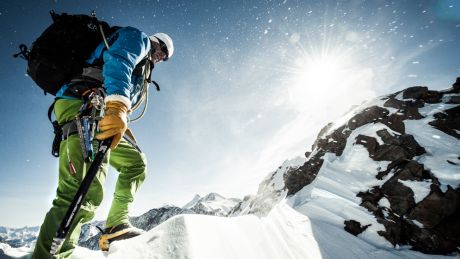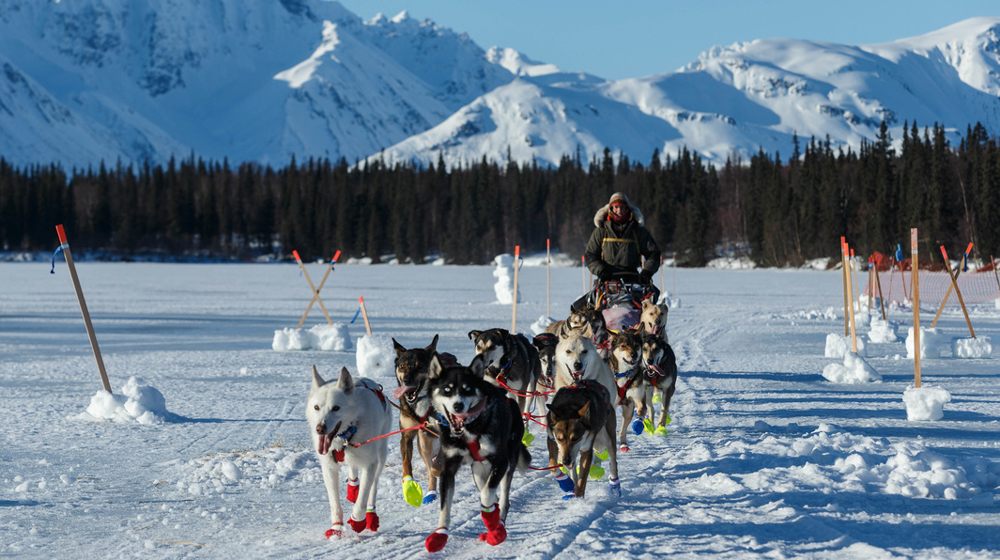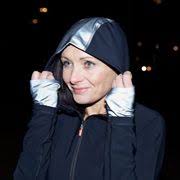Could You Do The World’s Greatest Adventure Challenges?
How tough are they? And could you really do them? Maybe, just maybe

From the comfort of an armchair, several of the world’s great challenges seem something of a stroll. That gentle slope of Kilimanjaro – how hard can it be? The Iditarod – you just stand on a sledge, right? Turns out they might actually be a little more demanding than that… but if you’re still not impressed, give them a shot. We found people who did.
Climbing Mount Kilimanjaro
What’s involved? The highest mountain in Africa, Kili stands nearly 6,000m above sea level. There are six main routes to the top, and Marangu – the shortest – is the most popular for newer climbers. It’ll still take around six days of slow walking though, as the thin air means it’s hard to catch your breath, so it’s recommended you spend at least five days on the mountain to acclimatise. While it’s not a technical climb, you’ll be carrying your kit and it’s the altitude sickness that’s the killer – around 75% of people suffer mild symptoms like headaches, shortness of breath, nausea and fatigue. Of the 35,000 trekkers that attempt to climb Kili each year, it’s estimated only 65% reach the summit.
How fit do I need to be? It’s not that challenging a climb so if you can trek for a day you should be fine. It helps to get a bit of experience of altitude, though, so if you’ve got the time, climb a smaller mountain first. Or take some simulated altitude training sessions at The Altitude Centre.
What’s it really like? Ross Johnson, a revenue growth manager from London, says: “I’d climbed Mount Toubkal in Morocco – the highest peak in northern Africa – and wanted to do the highest in southern Africa, which meant Kilimanjaro. I keep fit with squash and had taken to biking and open-water swimming, but I added some long walks with a backpack full of water to get used to carrying weight for long periods.
“The biggest challenge was always going to be the altitude – you can’t predict how it’s going to affect you until you’re actually at that height. While altitude wasn’t too much of a problem for me, I found the summit descent incredibly tough. Following days of walking mainly upwards at a slow altitude-adjusting pace, and having started the summit climb at 11pm, we descended quickly around mid-morning and the impact on my knees was excruciating. I was offered assistance getting back to camp, but I refused as it would have felt like I hadn’t achieved it under my own steam.
“If you’re thinking about climbing Kili, you have to do it – the views are amazing.”
Iditarod

What’s involved? In this 1,000-mile (1,600km) trail sled dog race across Alaska, mushers (the guys on the sleds) and teams of 16 dogs race through blizzards, gale-force winds and sub-zero temperatures for up to two weeks, camping at night. The harsh landscape features hills and mountain passes so you need to be tough, both physically and mentally.
Get the Coach Newsletter
Sign up for workout ideas, training advice, reviews of the latest gear and more.
How fit do I need to be? While the dogs are doing a lot of the work, mushing is still physically taxing because you’ll be out there for hours at a time. In demanding sections of the race you can be running behind the sled or pushing it to help the dogs out. You pedal the sled with one foot on the runners, one on the trail (a bit like a scooter), so you’re going to need strong quads and a good level of cardio fitness. You need to have entered at least three sled dog races before you can enter Iditarod. Check out the Siberian Husky Club of Great Britain to find out about the Aviemore Sled Dog Rally, the biggest in the UK.
What’s it really like? Rob Cooke from Canada says: “The sleep deprivation is pretty hard to prepare for. Typically a 1,000-mile race will take between eight and 13 days. You’ll be running for six to seven hours then camping for five. In that time you need to cook a meal for the dogs and get them bedded down. It’s not unusual to survive on two hours of sleep in the first few days.
“I don’t find 1,000-mile races that difficult and say that anyone could do them. That said, a third of people who start fail to finish so maybe it does take something different.”
Dakar Rally
What’s involved? More than 500 cars, trucks, motorcycles and quad bikes spend two weeks travelling 9,000 miles (15,000km) across South America (the name comes from the old route from Paris to Dakar, Senegal – the race moved in 2009 because of security concerns). The terrain gradually gets more demanding with undulating tracks, mountains, rivers and sand dunes to cope with. Most days competitors start around 5am and drive into the evening – the longest stage is over 900km – so this is a test of endurance as well as driving skill.
How fit do I need to be? While you might think driving doesn’t sound that taxing, you need to be light and lean to go fast. If you’re riding a bike it’s going to be physically demanding and you need to be practising regularly to get used to being in one position. Searing desert heat and altitude in the mountains are going to tax you physically, so good cardiovascular fitness is a must.
What’s it really like? Chris Cork, a builder from Devon, says: “I spent three years training for Dakar. I did a lot of mountain biking, which uses similar muscles, and ran because it was easy to fit around my schedule. The atmosphere was amazing and while some people worry about being alone on a bike all day, it was wonderful. I’m just a normal bloke – I think with the right training and the right mental attitude anyone can do it.”
North Pole Marathon
What’s involved? A 26.2-mile (42.1km) run in extreme sub-zero temperatures in one of the remotest parts of the planet. Forget roads – at the geographic North Pole, you’re running on ice while armed guards watch for polar bears. Frostbite and hypothermia are very real possibilities so getting your clothing and body temperature right is imperative. Sweat can freeze.
How fit do I need to be? You should be able to run a marathon and be mentally tough enough to cope with the extreme cold. Running on shifting ice and through snow will really take it out of you, so you’ll need good core and leg strength. It’s also going to take a while, so if following a traditional marathon training schedule, you’ll want to extend your long runs.
What’s it really like? Shona Thomson, an investment banker from London, says: “I followed a marathon schedule with 18- to 20-mile runs at the weekend and shorter runs in the week. Some people run in freezers to get used to the cold. Training can’t prepare you for the terrain, because it’s a drifting ice floe. Occasionally big lumps of ice pop up and it’s easy to fall. But with the mindset to keep putting one foot in front of the other, anything’s possible.”
RECOMMENDED: The 30 Greatest Outdoor Challenges
Marathon des Sables
What’s involved? Runners cover 156 miles (251km), or nearly six marathons, across the Sahara in six days. The daily stages vary from 21.1 to 82.2km, which sees runners going all day and into the desert night. And it’s hot – 48°C at noon. You carry food, clothes and your sleeping bag on your back, and bed down in bivouacs with seven other runners. Terrain is tough with dunes, plateaus and crevasses.
How fit do I need to be? This is less about being able to run fast and more about spending time on your feet. The energy-sapping sand is tough on your legs and core, and makes it hard to get up any pace – you’ll be out there for hours at a time.
What’s it really like? Tobias Mews, an adventurer and author from London, says: “The best training I did, aside from running, was Bikram yoga, to get used to the heat. Nothing compares to running in the Sahara, though. The best thing about the race was the camaraderie – that’s the life and soul of the MDS experience. Six people in my tent had never done a marathon and a couple had never even raced. That proves that anyone can do it.”
Sailing the Atlantic
What’s involved? Crossing the Atlantic takes you around 2,700 miles (4,350km) from Europe to the Caribbean. The crossing season happens every winter and you’ll be at sea for up to three weeks. The toughest part is the often-rough Bay of Biscay, after which it all gets nicer. Most yachts stop in the Canary Islands before cruising to the Caribbean, where the trade winds make for an easier crossing.
How fit do I need to be? The boat doesn’t sleep so you’ll work in shifts, which can be tiring, meaning cardiovascular fitness is a definite help. A sea survival course and learning how to fix equipment will be useful, and it’s worth taking crewing lessons.
What’s it really like? Dave Mills, a firefighter from Surrey, says: “I’d always sailed, but I was working on a farm when I first got a call asking if I fancied sailing the Atlantic. I was in reasonable shape from sailing and work so I didn’t specifically train but I was sport fit. A bit of strength work and cardio should get you in shape.
“We were delayed by ten days because there was a big storm, which was pretty hairy, but it took us about two weeks in total with a crew of six. Leaving the UK can be hard work because of the weather, but after the Canaries it tends to be easy sailing. Usually you’ll work in shifts with three hours on deck – driving, keeping watch or trimming the sails – and three hours off. Things break out there so there are times you’ll be crawling along the deck in water fixing engines, so staying calm is a vital skill. Whales are a big problem, too – they’re an amazing sight, but they can sink your boat.
“Physically there’s nothing to hold anyone back from sailing the Atlantic, it’s the mental side that’s the challenge. You’re isolated out there and you’re in a confined space.”
Climbing Everest
What’s involved? Around 600 climbers attempt to scale the 8,848m summit of Everest each year, but this is no simple job. You’ll trek to Base Camp to stay up to two weeks to acclimatise to the altitude and wait for a decent weather window. Then it’s an ascent over the crevasses and moving ice blocks of the Khumbu Icefall to Camp I at 6,000m. From Camp I you trek up a glacial valley to Advanced Base Camp and ascend fixed ropes to Camp III, before returning to Base Camp for rest and acclimatisation and doing it all again. From Camp III it’s a scramble over snow-covered rock to Camp IV and entering the enticingly named “Death Zone”, where you only have a few days to attempt the summit before lack of oxygen kills you.
How fit do I need to be? Cardio fitness is essential to help your heart and lungs cope with altitude so running, climbing and general cardio work are vital – on the North Face, a kilometre can take six hours. Exercising on hills will help your muscles get used to uneven ground and work the stabilising muscles it’s hard to reach in the gym. If you can, climb some other mountains first.
What’s it really like? Stuart Peacock, an expedition leader from Cumbria, says: “The physical part is only 30% of the challenge, 60% is mental and the rest is luck with the weather. When you’re camping your breath freezes on the inside of the tent, which is the kind of thing you can’t really prepare for at home. But I think with the right training and preparation, most people can achieve it.”
RECOMMENDED: UK Fitness Challenges

Charlotte Thomas is a freelance journalist and health and fitness blogger at Lunges & Lycra.
